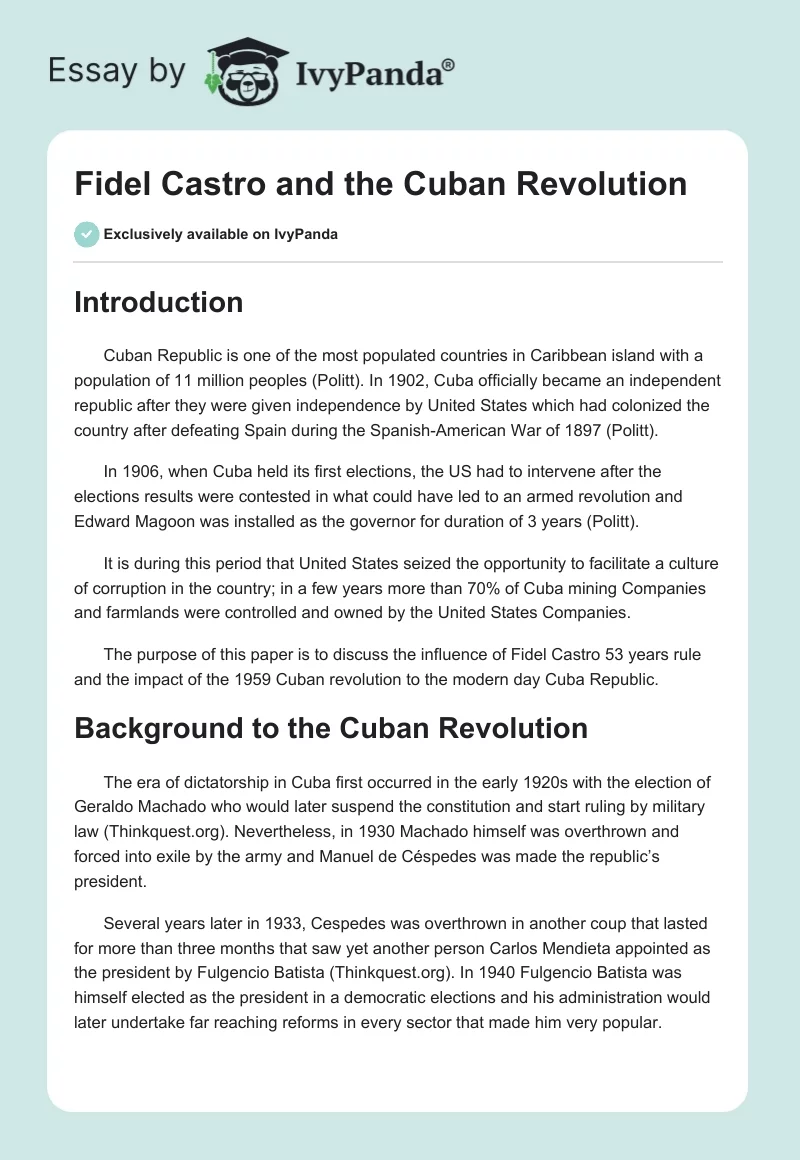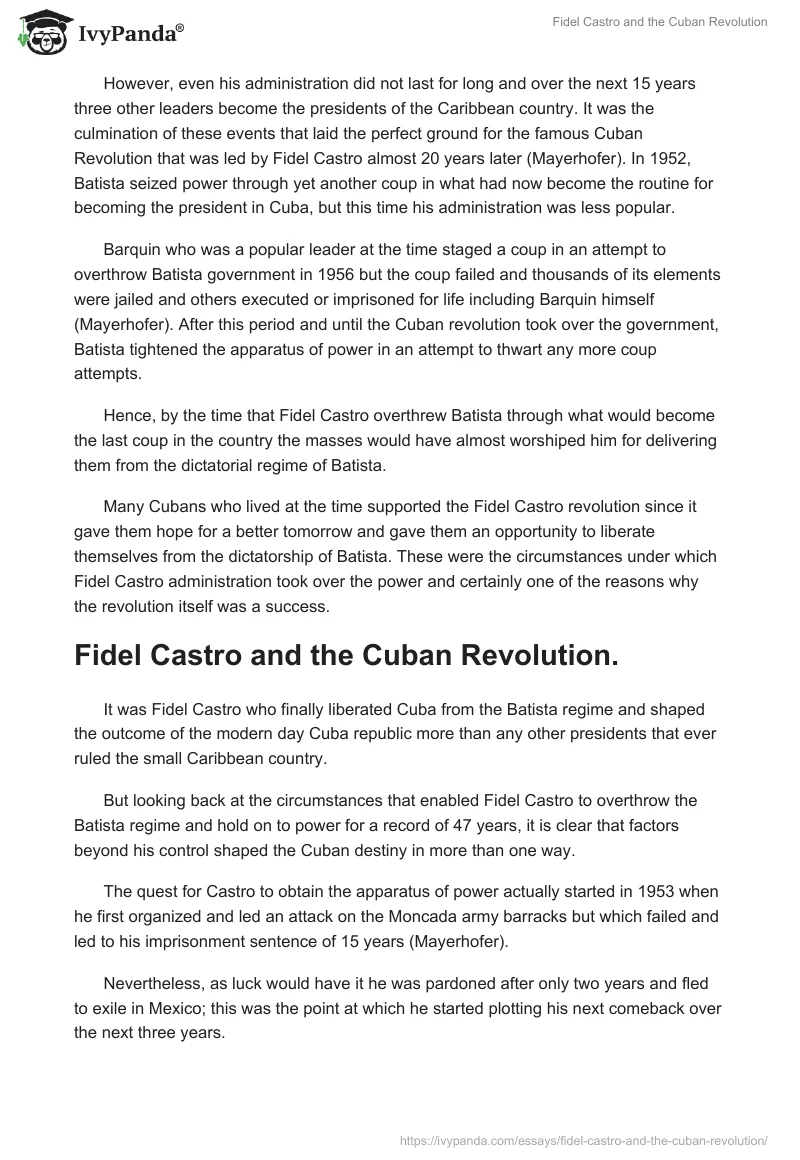Introduction
Cuban Republic is one of the most populated countries in Caribbean island with a population of 11 million peoples (Politt). In 1902, Cuba officially became an independent republic after they were given independence by United States which had colonized the country after defeating Spain during the Spanish-American War of 1897 (Politt).
In 1906, when Cuba held its first elections, the US had to intervene after the elections results were contested in what could have led to an armed revolution and Edward Magoon was installed as the governor for duration of 3 years (Politt).
It is during this period that United States seized the opportunity to facilitate a culture of corruption in the country; in a few years more than 70% of Cuba mining Companies and farmlands were controlled and owned by the United States Companies.
The purpose of this paper is to discuss the influence of Fidel Castro 53 years rule and the impact of the 1959 Cuban revolution to the modern day Cuba Republic.
Background to the Cuban Revolution
The era of dictatorship in Cuba first occurred in the early 1920s with the election of Geraldo Machado who would later suspend the constitution and start ruling by military law (Thinkquest.org). Nevertheless, in 1930 Machado himself was overthrown and forced into exile by the army and Manuel de Céspedes was made the republic’s president.
Several years later in 1933, Cespedes was overthrown in another coup that lasted for more than three months that saw yet another person Carlos Mendieta appointed as the president by Fulgencio Batista (Thinkquest.org). In 1940 Fulgencio Batista was himself elected as the president in a democratic elections and his administration would later undertake far reaching reforms in every sector that made him very popular.
However, even his administration did not last for long and over the next 15 years three other leaders become the presidents of the Caribbean country. It was the culmination of these events that laid the perfect ground for the famous Cuban Revolution that was led by Fidel Castro almost 20 years later (Mayerhofer). In 1952, Batista seized power through yet another coup in what had now become the routine for becoming the president in Cuba, but this time his administration was less popular.
Barquin who was a popular leader at the time staged a coup in an attempt to overthrow Batista government in 1956 but the coup failed and thousands of its elements were jailed and others executed or imprisoned for life including Barquin himself (Mayerhofer). After this period and until the Cuban revolution took over the government, Batista tightened the apparatus of power in an attempt to thwart any more coup attempts.
Hence, by the time that Fidel Castro overthrew Batista through what would become the last coup in the country the masses would have almost worshiped him for delivering them from the dictatorial regime of Batista.
Many Cubans who lived at the time supported the Fidel Castro revolution since it gave them hope for a better tomorrow and gave them an opportunity to liberate themselves from the dictatorship of Batista. These were the circumstances under which Fidel Castro administration took over the power and certainly one of the reasons why the revolution itself was a success.
Fidel Castro and the Cuban Revolution
It was Fidel Castro who finally liberated Cuba from the Batista regime and shaped the outcome of the modern day Cuba republic more than any other presidents that ever ruled the small Caribbean country.
But looking back at the circumstances that enabled Fidel Castro to overthrow the Batista regime and hold on to power for a record of 47 years, it is clear that factors beyond his control shaped the Cuban destiny in more than one way.
The quest for Castro to obtain the apparatus of power actually started in 1953 when he first organized and led an attack on the Moncada army barracks but which failed and led to his imprisonment sentence of 15 years (Mayerhofer).
Nevertheless, as luck would have it he was pardoned after only two years and fled to exile in Mexico; this was the point at which he started plotting his next comeback over the next three years.
In 1956 Castro returned with a well organized army of likeminded dissidents who were also forced into exile by the Batista regime and started guerilla warfare from the mountains of Sierra Maestra (Mayerhofer). For the next two years, Castro fighters sustained an armed attack against Batista government with the support of the mass that were largely on their side.
In fact a large proportion of the resources that the revolution relied on were provided by the citizens who believed in the changes that Castro promised to bring about when he took power. Most of the supporters were therefore businessmen who provided financial support, young men who joined the revolution as fighters and even peasants who provided shelter and food to the combatants once in a while.
In 1958, as luck would have it again the US government enforced an arms embargo on the administration of Batista government thereby weakening its ability to respond to Castro’s armed onslaught that was rapidly gaining momentum (Mayerhofer).
Thereafter the revolution became even more powerful; in early 1959, Castro army captured Havana which was the last stand of Batista army and the revolution was officially over (Mayerhofer). Within just one year Castro administration undertook even more reforms that turned the still young Cuban republic into a socialist military state.
This would be the start of far reaching reforms that would later be attributed to Fidel Castro’s administration and the Cuban revolution as well as.
Effects of Cuban Revolution and Fidel Castro administration
Among the immediate reforms that were implemented by Castro upon becoming the president was immediately reinforcing the army through training and ensuring that it was well equipped to crash any coups (Bunck). In a country that was dogged by coups year after year, this was hardly surprising and indicated the cunningness of the young general of making future attempts to overthrow his government impossible; and indeed it was.
These reforms in the area of military training would be the source of the country long relationship with USSR and ironically the reason that further polarized the relationship of Cuba with United States. In this arrangement, Russia, formerly USSR would equip Cuba with military hardware and all warship arsenals which was a very profitable venture at this early period of the arms race.
Besides, USSR was also making Cuba its ally that could prove valuable in case of a military conflict with US which was traditionally their foes. But the events of this period as orchestrated by USSR would later take a drastic turn in 1961 that led to what historians call the brink of the world war III due to the historic circumstances of the infamous Cuban Missile Crisis that almost changed the course of political history of the world as we know it today (Bunck).
In the aftermath of the Cuban Missile Crisis, Cuba was even further isolated from United States after it severed completely its diplomatic relations and instituted every economic sanctions that it could hand down towards Cuba.
Fidel Castro also became a subject of target by the US foreign intelligence services, more commonly referred as CIA (Bunck). These sanctions impacted heavily on the future ability of Cuba to prosper and certainly changed its course of history in a significant way.
Another sector that was significantly changed by the Castro administration was in the land sector. In 1959, Castro administration passed the Agrarian Reform Act which gave the government repossession powers and control of private land that totaled more than $25 billion which also included United States investor’s lands; this was another area that Cuba and United States were at odds (Bunck).
Besides these outcomes that are directly related to Cuba revolution and Fidel administration, other significant outcomes that can be linked to Castro 47 years in power are well run health and education programmes (Bunck). These pro-government reforms was one of the main reasons the people fanatically supported Castro’s administration during the early years since the government had the interest of its peoples at heart in every policy that it was implementing.
In addition the government promoted technological advances that led to the installation of the nuclear power plant which made it the only Caribbean country with a nuclear plant (Bunck). But amid these developments, the human rights deteriorated for each year that Fidel was in power as Castro worked hard to model the country as a socialist and a military state.
Conclusion
The Cuban revolution no doubt contributed to entrenched reforms and political changes to Cubans. Fidel Castro vision of a socialist state where every person could live in freedom, access free health care and free education was finally achieved. His struggle to initially free Cuba from dictatorial regimes came true and the creation of an independent economy was also enabled.
On the other hand, the question to many historians still remain whether Cuba gained more than it lost due to the 47 year rule by Fidel Castro. If the events of the last four years since he ceded power are anything to go by, it would also seem that Cuba probably lost more than it gained during this period.
Works Cited
Bunck, Marie. An Excerpt from Fidel Castro and the Quest for a Revolutionary Culture in Cuba, 2004. Web.
Mayerhofer, Phillip. The Rise and Rule of Fidel Castro during the Cuban Revolution, 2007. Web.
Politt, Brian. The Cuban Revolution after 50 Years, 2008. Web.
Thinkquest.org. Cuban Revolution, 2006. Web.


